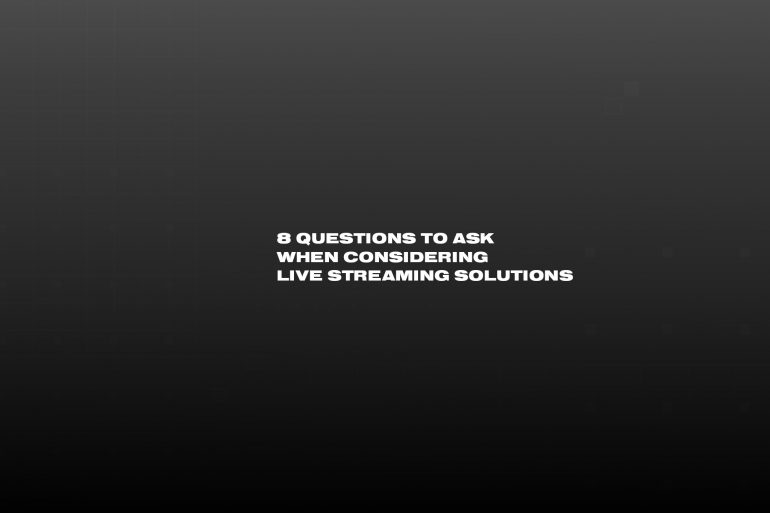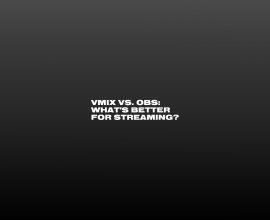8 Questions to Ask When Considering Live Streaming Solutions
For many organizations and ministries, live streaming is no longer optional.
It’s become a key method of engaging audiences and reaching people that couldn’t otherwise participate or receive your content.
There are many tools on the market that help organizations and businesses implement powerful, engaging live streams, each with differing capabilities and price points. If you’re working to figure out which live streaming solutions are worth considering, then asking the right questions is crucial.
To get you started, we’re giving you some questions you should ask about any live streaming solution you’re considering.
How many unique outputs do we need?
Handling multiple outputs is an element that may not matter much to Twitch and gaming streamers. But if you’re setting up video streaming solutions for live events, a house of worship, e-sports, or other more complex scenarios, multiple outputs is a must.
Before you choose among various live streaming solutions, take an inventory of your total unique output needs: main presentation display, IMAG, IMAG plus lower thirds, live stream, presenter view / Confidence Monitor, and so forth.
It’s possible to run these using a combination of software tools (like using a standalone tool to handle the live stream while your presentation software handles the rest). But you’ll have an easier, cleaner streaming experience if you choose presentation software that can handle all your outputs — including your live stream.
Can the solution produce lower thirds?
Lower thirds are graphical or textual overlays that show up over top of video content. In broadcast and lyric contexts they usually exist in the lower third of the screen (hence the name), but any graphical overlay anywhere on the screen tends to get lumped into this category.
If you’re using a center screen for your presentation output (slide deck) and side screens for IMAG, you might not need lower thirds on either. But when you set up a live stream, you’ll almost certainly need either this or PIP to create a cohesive stream.
Lower thirds are simple in ProPresenter, and they can be applied to individual outputs as needed.
Will we need PIP capability?
Let’s revisit that live presentation or church service scenario above, with the center screen running a slide deck and side screens running as IMAG video screens. Your remote audience needs to see the content from both screens. If that slide deck content is simple (like song lyrics), lower thirds work well.
But what if you’re using visual-heavy or information-rich slide content (such as what a speaker might use in a keynote or a sermon)? That content won’t translate into lower thirds.
Instead, you may need to display both outputs simultaneously using picture-in-picture (PIP). If so, you’ll need to verify that a live streaming solution can support this function.
Additionally, if you’re using an external video switcher that doesn’t support keying, you may need PIP as an alternative to lower thirds. Or you could just switch to ProPresenter and handle video switching within your presentation and live streaming software.
Speaking of:
Does this solution include content & video switching without the need for an additional app or hardware switcher?
The more software and hardware components your system needs, the more complexity you have to deal with. And don’t forget that every additional element is a new potential point of failure.
It’s possible to use separate apps (or even hardware) to handle each of these functions:
- Presentation design and display
- Video display
- Encoding (hardware or software)
- Video switching
Or you could use ProPresenter, which easily handles all of this within a single powerful software engine. With ProPresenter 7, you can create presentation content and pull in all your other content and video, then use ProPresenter as your video switcher and software encoder.
By eliminating extra tools, hardware, and steps, you’ll simplify your live streaming solutions efforts and likely improve stream reliability and quality.
Are the stream design tools sufficient?
Whether you’re a solo streamer or you’re representing a large venue or ministry with complex needs, everyone needs stream design tools. Stream design is the process of building out a default look and feel for your stream, with somewhat consistent elements that make your stream look like your stream.
Available live streaming solutions can vary widely in their capabilities here. Some, like ProPresenter, are fully featured presentation design tools already, giving you and advanced professional slide and content editor with practically zero limits. Other solutions may cover the technical elements of streaming well but offer a limited stream design experience.
Take time now to determine what kinds of needs you have for stream design, then evaluate whether each live streaming solution’s tools for stream design are sufficient for your needs.
Does the solution support the formats we’re using?
Every live streaming solution worth considering will support standard audio and video formats, including content captured from popular capture devices like the Elgato HD60 series or Blackmagic devices. But the more complex your environment, the more robust you need your live streaming solution to be.
ProPresenter can handle all of the standard stuff, plus plenty more, including formats that are popular in broadcast contexts like SDI, NDI, and Syphon.
Is the streaming solution reasonably future-proof (and something you won’t outgrow)?
If your organization is growing or is still maturing in its use of live streaming, make sure you don’t invest now in video streaming solutions that you’ll outgrow in just a few years.
Some tools (like free web-based Microsoft PowerPoint alternative tools or streaming tools with a free version) may be enough for your current needs. But if your needs grow as your organization does, you may run into frustrating limits as you outgrow a simpler solution.
So as you evaluate potential live streaming solutions, think about the needs you may have in the next 3 to 5 years — not just the needs you have today.
Is the software highly reliable and capable of producing a resilient stream?
Your live stream matters, so you want to make sure the largest audience possible can access the stream — without drops, crashes, or other avoidable problems.
Choosing a professional-grade live streaming solution is the first step: by using reliable, supported software to power your stream, you’ll encounter fewer problems on the stream creation and upload side.
There’s still the matter of resiliency, though. Only ProPresenter gives you access to Resi’s Resilient Streaming Protocol (RSP), an evolutionary leap past the standard RTMP protocol. Resi adds error correction to make streams smoother and can even survive an outage of up to two minutes.
Across all these questions, one solution consistently ranks above the rest: ProPresenter 7. It’s a true professional-grade solution for streaming, presentation design, video switching, software encoding, and more.
Ready to see for yourself? Download now and start streaming with your free two-week trial!




